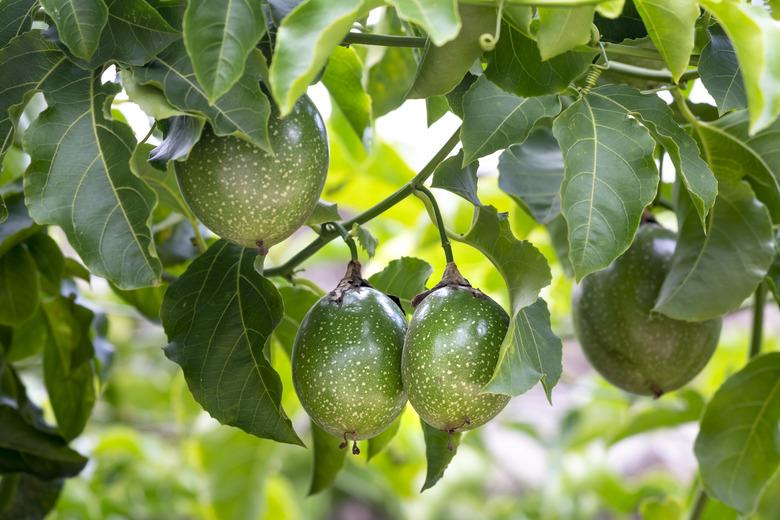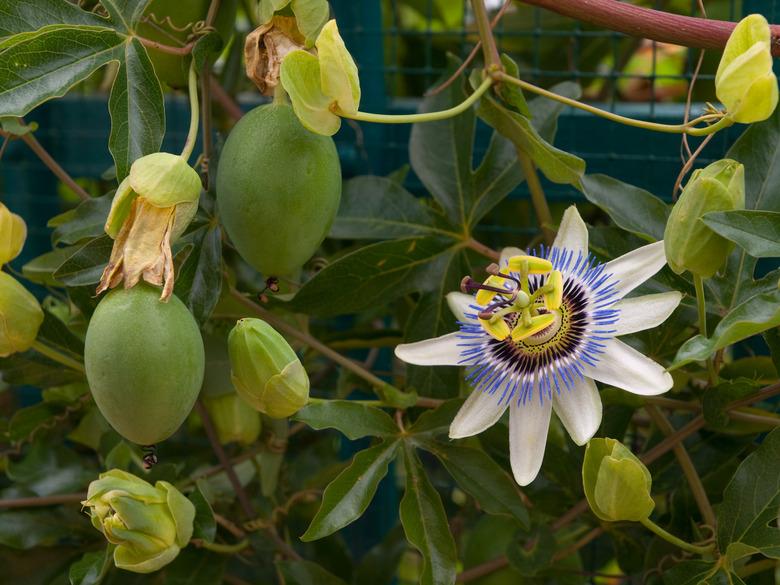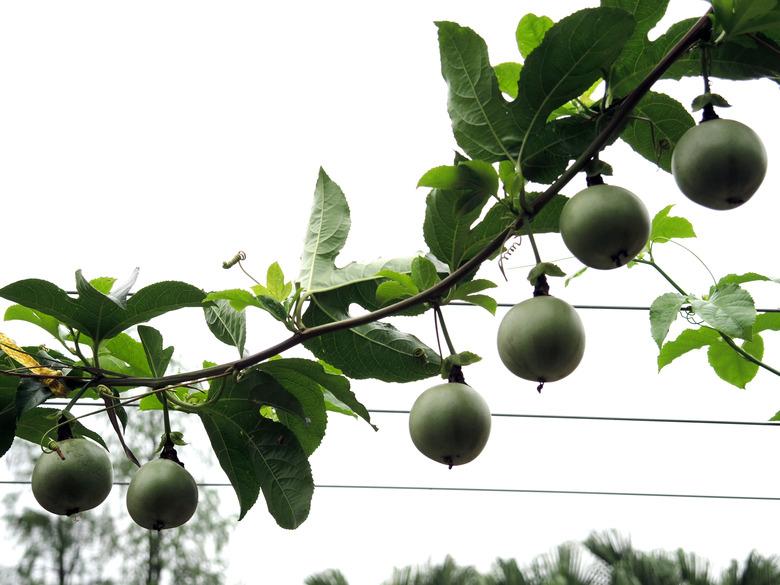How To Grow Passion Fruit
Passion fruit vines (Passiflora spp.) produce delicious berries (yes, passion fruit is a type of berry) with a tart, sweet taste that is almost impossible to dislike, but they are nothing compared to the insanely showy passion flowers that precede them. Surrounded by fringy petals against flat sepals, the flowers look as if they were sculpted in an artist's studio, and the overall effect is at once complex and unearthly. The native passion fruit species, Passiflora incarnata (USDA plant hardiness zones 5-9), prompted 16th-century Catholic priests visiting South America to compare them to the passion of Christ, which is how the plant got its common name.
Purple granadilla passion fruit (Passiflora edulis, USDA zones 10-12) is native to the tropical and semitropical rainforests of Paraguay, Argentina, and Brazil, and with all the showiness it offers, it's no wonder that gardeners in North America have adopted it. Unlike the yellow passion fruit (Passiflora edulis var. flavicarpa), a passion fruit variety that grows only in the tropics, the purple passion fruit will grow outdoors in southerly regions where it can get the moderate amount of water it needs. The vine can reach 30 feet long, although it's usually shorter, and it needs plenty of support, which makes passion fruit a great plant for an outdoor or greenhouse trellis, arbor, or wall.
Passion fruit vines produce berries and flowers simultaneously, and the flowers are short-lived, lasting only a day. The berry, which forms when the flower drops, is egg-shaped and has a soft rind. The inside is filled with seeds, each within its own gel-filled sac, both of which are edible. Some passion flower species produce inedible fruit, but they generally prefer tropical climates and aren't as common in North America as other species.
Here's everything you need to know about growing passion fruit.
How to Grow Passion Fruit
Starting Passion Fruit From Seed
You can grow passion fruit vines from seeds obtained from store-bought fruit but keep in mind that older seeds take longer to germinate, so choose fresh fruit. The best seeds come from fruit that has a slightly crinkled rind, which doesn't mean the fruit is old, just that it's ripe. To improve the chances of germination, rub the seeds against sandpaper and then soak them overnight in warm water.
Sow the seeds in small containers filled with soil mix or a mix of soil and compost, burying them about a half-inch deep and placing two in each container to increase the chances of a successful seedling. If both seeds germinate, pinch off the weaker one at ground level.
Keep the soil moist but not wet until the seedlings emerge and then plant them when they are about 8 inches high. If you wait too long and the leaves start to develop, prune the plants back to reduce moisture loss through the leaves and to help the roots settle.
Passionflower seeds can be slow to germinate, but germination is improved when the seeds are given a chilling period, which you can do in your refrigerator. Simply place moist potting mix or seed-starting mix into a zippered plastic bag. Fill the bag halfway with the mix and then press the seeds into the mix until they're covered. Keep the bag in the refrigerator for 90 days. When you remove the bag, empty the mix with the seeds into a container with drainage holes, making sure that the seeds are covered. Keep the mix moist until the seeds germinate and transplant seedlings when they have two sets of true leaves.
Starting Passion Fruit From a Seedling
Mature passion fruit root balls grow large, and the vine grows quickly and can overrun anything growing nearby, so it needs a lot of space. The recommended spacing between vines or between a vine and another plant is 10 feet to 12 feet. A sturdy support structure should be provided for the vine when you plant it. You may have to tie the vine to the base of the structure, but soon the tendrils will get the idea, and the vine will start climbing.
Dig a hole that is twice the size of the transplant and at least as deep as the pot in which it's growing. Carefully remove the plant from the pot, being mindful not to damage the fragile roots (or the plant may die). Put it in the hole and backfill loosely until the plant is stable. Wet down the soil to make it settle and then mulch heavily with organic matter to retain moisture in the soil.
In What Zone Does Passion Fruit Grow Best?
Because it comes from tropical and semitropical regions, purple passion fruit is hardy only in zones 10 through 12, but the native North American species is hardy to zone 5. Maypop (Passiflora incarnata) is so-named because of the popping sound the berries make when you step on them, and gardeners grow them as far north as Ohio.
When Should You Plant Passion Fruit?
If you plant passion fruit in the late winter or early spring, you have a good chance of getting fruit in autumn. If you aren't concerned about getting fruit, you can plant the vine any time of year, but autumn is probably best.
Where to Grow Passion Fruit
Passion fruit can thrive in a variety of planting situations. Here are a few ideas on where to grow passion fruit:
- Near a fence: Left to its own devices, passion fruit can be an unruly presence in the garden and grows vigorously enough to be considered invasive in some areas, but vigorous growth can be a benefit if you have an old, rusty fence or some other eyesore to cover. The passion fruit vine grows quickly, and it can replace an eyesore with a sight for sore eyes in a single growing season.
- In a container: Passion fruit vine is also a good container plant that can be moved into a greenhouse for the winter as long as the container includes a sturdy support structure.
- In an edible garden: Of course, many people grow passion fruit for the berries, which take 60 to 80 days to ripen on the vine after the flower falls. Berries and flowers grow side by side, so the vine can double as a showy garden feature and a source of food. The main vine grows along the support structure you provide for it, and it sends out lateral shoots that bear fruit.
Passion fruit vines grow as perennials in zones in which they are hardy. Some types of passion vines are self-pollinating, but others rely on pollinators, such as bees, for cross-pollination, and even self-pollinating plants produce better fruit when pollinated by bees, especially carpenter bees. Consequently, it's a good idea to plant them alongside herbs and flowers that attract these pollinating insects.
Soil, Sunlight, and Water Recommendations for Passion Fruit
To thrive, passion fruit vines need the right type of soil and amendments, adequate water, and the proper amount of sunlight. Here's the scoop on all three:
- Soil: The passion fruit vine likes loose, well-drained soil. If the soil is very sandy, it's a good idea to mix in compost or aged manure to ensure the plants get off to a good start. Fortify depleted soil with a 10-5-20 fertilizer, keeping in mind that excess nitrogen produces lush foliage but smaller fruit.
- Water: Passion fruit needs a steady supply of water but don't overdo it. Standing water causes root rot, and passion fruit is particularly susceptible to this disease.
- Sunlight: The plants grow best in 60 to 80 percent relative humidity. They need to be in full sun, but they will tolerate a little shade, and they may need to be shaded in very hot, sunny weather.
How to Propagate Passion Fruit
You can grow passion fruit plants from seeds (as described above) or cuttings. Select a 6-inch tip cutting of new growth (which grows faster than old growth), remove the lower leaves and set the base in a pot filled with sand or sandy soil after first dipping it in root-growth hormone to stimulate growth. Put the pot in a greenhouse or a similar warm place and keep the soil moist but not wet. It helps to cover the pot with plastic to keep the humidity high, but make sure not to place the pot in direct sun. Roots take 30 to 90 days to develop.
How to Winterize Passion Fruit
Passion fruit vines can survive outdoors in the hardiness zones that are species-specific to the plant you have. When winter comes, increase the mulch layer around the base of the plant to 2 inches in thickness to protect the roots from the cold. If you have potted plants, take them indoors.
How to Harvest Passion Fruit
One of the nice things about passion fruit is that you don't have to harvest it. All you have to do is wait for the ripe fruit to fall from the vine, which happens more or less continuously throughout the growing season. Unlike apples or avocados, passion fruit doesn't ripen after you pick it, and if you pick it before it falls, the fruit will be sour. The two signs of ripeness are a strong, pleasant aroma and a shriveled, crinkled rind.
Common Pests and Other Problems for Passion Fruit
If you don't protect your passion flower plants with a protective barrier, you're likely to lose some of the best fruit to deer, and the young plants look like tempting morsels to any rabbits in the neighborhood. Products like Liquid Fence can help keep these critters away.
A number of insects are also interested in passion fruit, but fortunately, most of these live in the tropics. The ones of most concern in North America are aphids, Gulf fritillary butterflies, nematodes, and snails.
Aphids are a problem for pretty much any plant with leaves. These tiny crawlies congregate on the undersides of leaves and deposit a sticky substance called honeydew, which attracts ants. If you see ants tracking up a stem, you can be fairly sure that aphids are present. You can usually dislodge aphids by spraying them with water or insecticidal soap or even water.
Passion vines are host plants for the orange Gulf fritillary butterfly, also known as the passion butterfly. Although the butterflies don't do much damage themselves, the orange and black caterpillars have voracious appetites and can decimate the leaves of passion fruit plants. They probably won't kill the plant, but if the damage is extensive, pick them off and find them a better home.
In addition, nematodes can attack the roots, and snails will eat the foliage. You can't do much about nematodes other than to uncover the roots and expose them to sunlight, and you can deal with snails by trapping them in vessels filled with beer.
Common Diseases of Passion Fruit
Diseases that affect passion fruit plants can be divided into two categories: viral and fungal. Aphids are the No. 1 carriers of viral diseases, although they can also be spread by contaminated cutting tools. The diseases cause poor flowering and can interfere with fruit production.
Fungal diseases usually form ugly spots on the leaves or will cause them to wilt. The list of fungal diseases is fairly long and includes:
- Fusarium wilt
- Anthracnose
- Crown rot
- Collar rot
- Septoriosis
Treating plants with a fungicide in early spring can help prevent fungal diseases and so can good cultural practices, such as watering from below and engaging in regular pruning to promote air circulation among the leaves. Once a fungal infection occurs, it can be difficult to control, and you may have to remove affected branches.


